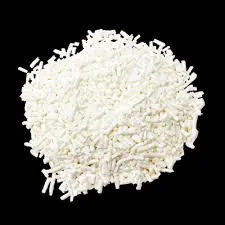
styrene rubber
Understanding Styrene Rubber Properties and Applications
Styrene rubber, commonly known as styrene-butadiene rubber (SBR), is a synthetic rubber that plays a crucial role in various industries due to its outstanding properties. Developed in the early 20th century, SBR has become one of the most widely used synthetic elastomers in the world. The characteristics of styrene rubber make it a preferred material for demanding applications, especially in the automotive and manufacturing sectors.
Composition and Properties
Styrene rubber is a copolymer made from the polymerization of styrene and butadiene. The combination of these two monomers results in a product that exhibits excellent resilience, abrasion resistance, and flexibility. SBR can be produced in various grades, which can be tailored to meet specific performance requirements. The unique microstructure of SBR provides a balance of mechanical strength and elongation, making it suitable for various applications.
One of the notable features of styrene rubber is its excellent aging resistance. Unlike natural rubber, SBR maintains its properties over extended periods, even under adverse environmental conditions. This longevity is essential for products that are exposed to heat, ozone, and other damaging factors.
Applications of Styrene Rubber
styrene rubber

The versatility of styrene rubber allows for its use in a wide range of applications. One of the most significant uses of SBR is in the production of tires. The rubber's durability and resistance to wear make it an ideal choice for tire manufacturing, where performance and safety are paramount. SBR contributes to better traction and longer lifespan of tires, essential attributes for both passenger vehicles and heavy-duty trucks.
In addition to tire production, styrene rubber is widely used in the automotive industry for a variety of components. It is found in gaskets, seals, and hoses, where its elasticity and resistance to chemicals and heat enhance the performance and reliability of these parts. Furthermore, SBR is employed in the manufacturing of conveyor belts, shoe soles, and various types of molding applications.
Environmental Considerations
As with many synthetic materials, the production and disposal of styrene rubber raise environmental concerns. Manufacturers are increasingly looking for ways to improve the sustainability of SBR, focusing on reducing waste during production and developing recycling processes for used rubber products. Innovations in green chemistry are paving the way for more eco-friendly alternatives in rubber production, promoting a circular economy.
Conclusion
Styrene rubber is a remarkable synthetic material with a wide array of applications, particularly in the tire and automotive industries. Its exceptional properties, such as resilience, durability, and aging resistance, make it an ideal choice for various products. As industries continue to advance and seek sustainable solutions, the future of styrene rubber will likely involve innovative manufacturing practices and recycling efforts, showcasing its potential to adapt to modern environmental challenges while maintaining its fundamental benefits.
-
The Safety Challenges of Ammonium Nitrate FertilizerNewsJun.26,2025
-
The Critical Role of Mining ChemicalsNewsJun.26,2025
-
Shelf Life of Glacial Acetic Acid Food GradeNewsJun.26,2025
-
Enhancing PVC Longevity with 1,2,3-Benzotriazole InnovationsNewsJun.26,2025
-
China’s Dominance in Food Additive ProductionNewsJun.26,2025
-
Can Aluminum Hydroxide Replace More Toxic Alternatives?NewsJun.26,2025
-
PE and PP Plastics with Benzotriazole AdditivesNewsJun.12,2025
Hebei Tenger Chemical Technology Co., Ltd. focuses on the chemical industry and is committed to the export service of chemical raw materials.
-

view more DiethanolisopropanolamineIn the ever-growing field of chemical solutions, diethanolisopropanolamine (DEIPA) stands out as a versatile and important compound. Due to its unique chemical structure and properties, DEIPA is of interest to various industries including construction, personal care, and agriculture. -

view more TriisopropanolamineTriisopropanolamine (TIPA) alkanol amine substance, is a kind of alcohol amine compound with amino and alcohol hydroxyl, and because of its molecules contains both amino and hydroxyl. -

view more Tetramethyl Thiuram DisulfideTetramethyl thiuram disulfide, also known as TMTD, is a white to light-yellow powder with a distinct sulfur-like odor. It is soluble in organic solvents such as benzene, acetone, and ethyl acetate, making it highly versatile for use in different formulations. TMTD is known for its excellent vulcanization acceleration properties, which makes it a key ingredient in the production of rubber products. Additionally, it acts as an effective fungicide and bactericide, making it valuable in agricultural applications. Its high purity and stability ensure consistent performance, making it a preferred choice for manufacturers across various industries.











